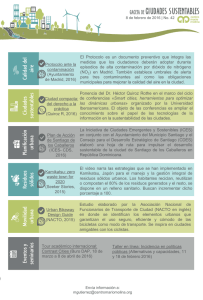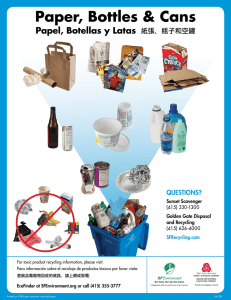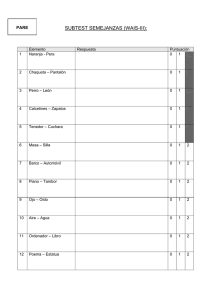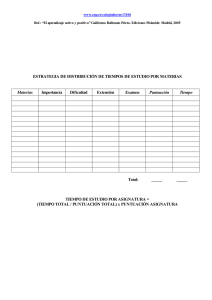Junio - Universidad Autónoma de Madrid
Anuncio
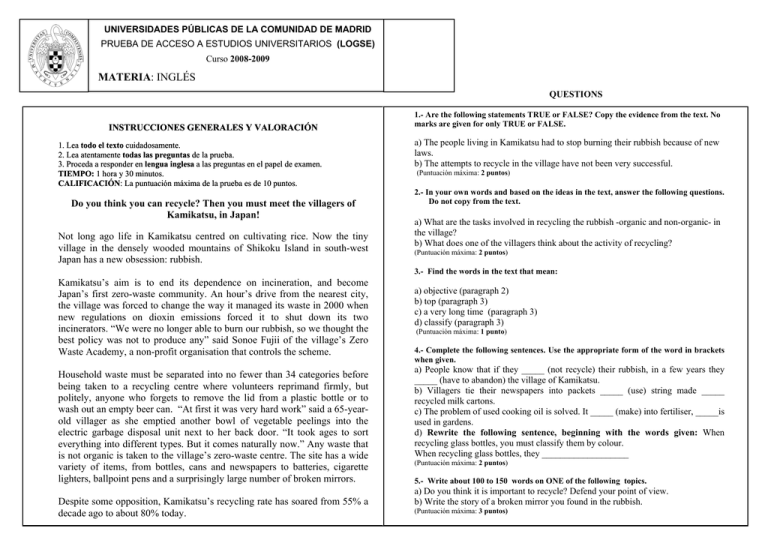
UNIVERSIDADES PÚBLICAS DE LA COMUNIDAD DE MADRID PRUEBA DE ACCESO A ESTUDIOS UNIVERSITARIOS (LOGSE) Curso 2008-2009 5 MATERIA: INGLÉS QUESTIONS INSTRUCCIONES GENERALES Y VALORACIÓN 1. Lea todo el texto cuidadosamente. 2. Lea atentamente todas las preguntas de la prueba. 3. Proceda a responder en lengua inglesa a las preguntas en el papel de examen. TIEMPO: 1 hora y 30 minutos. CALIFICACIÓN: La puntuación máxima de la prueba es de 10 puntos. Do you think you can recycle? Then you must meet the villagers of Kamikatsu, in Japan! Not long ago life in Kamikatsu centred on cultivating rice. Now the tiny village in the densely wooded mountains of Shikoku Island in south-west Japan has a new obsession: rubbish. 1.- Are the following statements TRUE or FALSE? Copy the evidence from the text. No marks are given for only TRUE or FALSE. a) The people living in Kamikatsu had to stop burning their rubbish because of new laws. b) The attempts to recycle in the village have not been very successful. (Puntuación máxima: 2 puntos) 2.- In your own words and based on the ideas in the text, answer the following questions. Do not copy from the text. a) What are the tasks involved in recycling the rubbish -organic and non-organic- in the village? b) What does one of the villagers think about the activity of recycling? (Puntuación máxima: 2 puntos) 3.- Find the words in the text that mean: Kamikatsu’s aim is to end its dependence on incineration, and become Japan’s first zero-waste community. An hour’s drive from the nearest city, the village was forced to change the way it managed its waste in 2000 when new regulations on dioxin emissions forced it to shut down its two incinerators. “We were no longer able to burn our rubbish, so we thought the best policy was not to produce any” said Sonoe Fujii of the village’s Zero Waste Academy, a non-profit organisation that controls the scheme. Household waste must be separated into no fewer than 34 categories before being taken to a recycling centre where volunteers reprimand firmly, but politely, anyone who forgets to remove the lid from a plastic bottle or to wash out an empty beer can. “At first it was very hard work” said a 65-yearold villager as she emptied another bowl of vegetable peelings into the electric garbage disposal unit next to her back door. “It took ages to sort everything into different types. But it comes naturally now.” Any waste that is not organic is taken to the village’s zero-waste centre. The site has a wide variety of items, from bottles, cans and newspapers to batteries, cigarette lighters, ballpoint pens and a surprisingly large number of broken mirrors. Despite some opposition, Kamikatsu’s recycling rate has soared from 55% a decade ago to about 80% today. a) objective (paragraph 2) b) top (paragraph 3) c) a very long time (paragraph 3) d) classify (paragraph 3) (Puntuación máxima: 1 punto) 4.- Complete the following sentences. Use the appropriate form of the word in brackets when given. a) People know that if they _____ (not recycle) their rubbish, in a few years they _____ (have to abandon) the village of Kamikatsu. b) Villagers tie their newspapers into packets _____ (use) string made _____ recycled milk cartons. c) The problem of used cooking oil is solved. It _____ (make) into fertiliser, _____is used in gardens. d) Rewrite the following sentence, beginning with the words given: When recycling glass bottles, you must classify them by colour. When recycling glass bottles, they ___________________ (Puntuación máxima: 2 puntos) 5.- Write about 100 to 150 words on ONE of the following topics. a) Do you think it is important to recycle? Defend your point of view. b) Write the story of a broken mirror you found in the rubbish. (Puntuación máxima: 3 puntos) INGLÉS CRITERIOS ESPECÍFICOS DE CORRECCIÓN TIEMPO: 1 hora y 30 minutos La prueba consistirá en el “análisis” de un texto de un idioma extranjero (el inglés en este caso), del lenguaje común, no especializado. A partir del texto propuesto, el estudiante realizará un comentario personal y responderá a cuestiones relacionadas con el texto, que serán planteadas y respondidas por escrito en el mismo idioma, sin ayuda de diccionario ni de ningún otro manual didáctico” (BOE n° 257). El texto contendrá alrededor de 250 palabras y su comprensión no exigirá conocimientos especializados ajenos a la materia de la prueba. La dificultad del texto estará controlada, a fin de permitir al alumno que realice la misma en el tiempo previsto. La puntuación total del examen será de 10 puntos. Al comienzo de la prueba se incluirán unas instrucciones generales para la realización de la misma en lengua castellana. El resto de la prueba estará totalmente redactada en inglés, y el alumno usará exclusivamente la lengua inglesa en sus respuestas. Valoración objetivos de cada una de las preguntas: Pregunta 1: Hasta 2 puntos. Se trata de medir exclusivamente la comprensión lectora. El alumno deberá decidir si dos frases que se le presentan son verdaderas o falsas, copiando a continuación únicamente el fragmento del texto que justifica su elección. Se otorgará 1 punto por cada apartado. Se calificará con 0 puntos la opción elegida que no vaya justificada. Pregunta 2: Hasta 2 puntos. Se pretende comprobar dos destrezas: la comprensión lectora y la expresión escrita, mediante la formulación de dos preguntas abiertas que el alumno deberá contestar basándose en la información del texto, pero utilizando sus propias palabras en la respuesta. Cada una de las preguntas valdrá 1 punto, asignándose 0,5 puntos a la comprensión de la pregunta y del texto, y 0,5 a la corrección gramatical de la respuesta. Pregunta 3: Hasta 1 punto. Esta pregunta trata de medir el dominio del vocabulario en el aspecto de la comprensión. El alumno demostrará esta capacidad localizando en el párrafo/s que se le indica un sinónimo adecuado al contexto, de cuatro palabras o definiciones. Se adjudicará 0,25 por cada apartado. Pregunta 4: Hasta 2 puntos. Con esta pregunta se pretenden comprobar los conocimientos gramaticales del alumno, en sus aspectos morfológicos y/o sintácticos. Se presentarán oraciones con huecos que el alumno deberá completar/rellenar. También podrán presentarse oraciones para ser transformadas, u otro tipo de item. Se adjudicará 0,25 a cada “hueco en blanco”, y en el caso de las transformaciones o items de otro tipo se concederá 0,5 con carácter unitario. Pregunta 5: Hasta 3 puntos. Se trata de una composición -de 100 a 150 palabras- en la que el alumno podrá demostrar su capacidad para expresarse libremente en lengua extranjera. Se propondrán dos opciones entre las que el alumno elegirá solo una. Se otorgarán 1,5 puntos por el buen dominio de la lengua –léxico, estructura sintáctica, etc.- y 1,5 por la madurez en la expresión de las ideas -organización, coherencia y creatividad.
